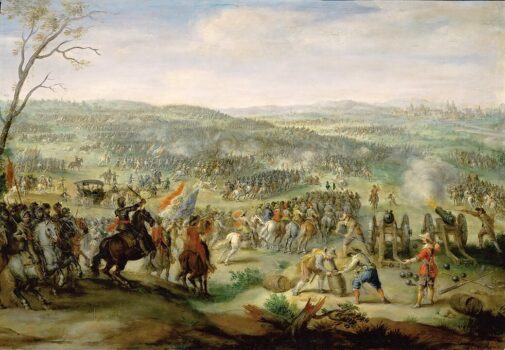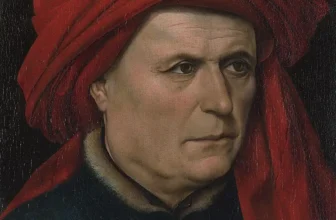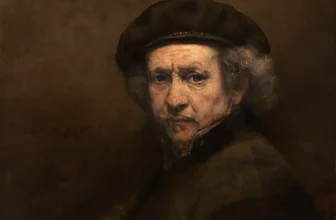The Battle of White Mountain Painting by Pieter Snayers
A Deep-Dive into Meaning, Symbolism, and Historical Context
Among the vivid visual narratives of the Thirty Years’ War, the painting The Battle of White Mountain by Pieter Snayers stands as a seminal work of historical art. Rendered in the first half of the 17th century, this panoramic battlefield painting immortalizes one of the pivotal conflicts in early modern European history, the Battle of White Mountain, fought on November 8, 1620, near Prague. Far more than a literal depiction of a military confrontation, Snayers’ work serves as a masterclass in artistic reportage, propagandistic symbolism, and historical narrative painting.
This essay delves into a comprehensive analysis of the painting’s context, meaning, style, and symbolism. It will examine what the painting portrays, why it was created, who Pieter Snayers was, and how this piece of art communicates not just a historical event, but a profound ideological message.
Who Painted The Battle of White Mountain?
Pieter Snayers (1592–1667), a prominent Flemish Baroque painter, is the artist behind The Battle of White Mountain. Snayers specialized in panoramic battle scenes, often working in collaboration with court painters or under the patronage of European nobility, particularly the Habsburgs. His ability to meticulously portray military detail while capturing the broader narrative scope of war earned him distinction across the courts of Europe.
Snayers’ affiliation with the Habsburg dynasty deeply influenced his subject matter. As a court painter to the Spanish branch of the Habsburgs, he was often commissioned to commemorate victories important to the dynasty. The Battle of White Mountain reflects this context, portraying not only a key military success for Catholic Habsburg forces but also a symbolic triumph of Counter-Reformation ideology over Protestant rebellion.
What is the Battle of White Mountain all about?
Before analyzing the painting, it’s important to understand the historical event it depicts. The Battle of White Mountain was a decisive early battle in the Thirty Years’ War, a sprawling and destructive conflict that engulfed much of Europe between 1618 and 1648. This particular battle was fought just outside Prague and marked a crushing defeat for the Protestant Bohemian forces at the hands of the Catholic League, led by Count Johann Tserclaes of Tilly and supported by Habsburg troops.
The battle resulted in the reassertion of Habsburg control over Bohemia and heralded a harsh re-Catholicization campaign, including the execution of rebel leaders and forced conversions. It had deep religious, political, and cultural ramifications, and came to symbolize the might of the Catholic Reformation. This symbolic weight is infused into Snayers’ painting.
What Is Happening in The Battle of White Mountain Painting?
At first glance, Snayers’ painting overwhelms the viewer with its panoramic sweep and topographical detail. The vantage point is elevated and distanced, allowing a bird’s-eye view of the entire battlefield. The viewer can make out the positioning of troops, terrain, and even architectural landmarks of the Prague region.
The Catholic forces are advancing from the left, shown in disciplined formations, while the Protestant troops are scattered and in disarray. This juxtaposition serves as both a visual narrative and ideological statement. The chaos of the Protestant forces suggests their spiritual and organizational inferiority, while the orderly Catholic troops symbolize divine order and righteous conquest.
Several key figures can be identified by their clothing and positioning. These include the Catholic commanders, Tilly and Maximilian I, Elector of Bavaria, rendered in heroic and commanding postures. Although the painting is not a portrait of individuals, Snayers includes enough detail to emphasize the presence of historical personalities central to the Habsburg narrative of victory.
In the background, the city of Prague looms, reinforcing the geographical specificity of the event and suggesting the stakes of the battle. The city serves as both a prize and a witness to the unfolding events, further highlighting the importance of this military and ideological conquest.
who won the battle of white mountain
The Battle of White Mountain took place near Prague, in the Kingdom of Bohemia (now the Czech Republic), and marked a significant Catholic victory over the Protestant forces. The battle was a turning point that ended the Bohemian phase of the war and had lasting consequences for the region.
The conflict began after Protestant nobles in Bohemia rebelled against the Catholic Habsburg emperor, Ferdinand II. In 1618, these nobles staged the Defenestration of Prague, where they threw two imperial officials out of a castle window, sparking a revolt. In response, the Bohemians deposed Ferdinand II and elected Frederick V of the Palatinate, a Protestant prince, as their new king. This challenged Habsburg authority and escalated into open warfare.
The Catholic forces were led by the seasoned commanders Johann Tserclaes, Count of Tilly, and Charles Bonaventure de Longueval, Count of Bucquoy. They commanded the Imperial Army, which was better trained, equipped, and organized than the Protestant Bohemian forces under Christian of Anhalt, who served Frederick V.
The battle occurred just outside Prague on a plateau called White Mountain. The Protestant army, numbering about 15,000, positioned itself defensively. However, they faced a stronger Catholic army of approximately 27,000. The Imperial forces launched a decisive and well-coordinated attack. Despite the terrain advantage, the Protestant troops were poorly prepared, inexperienced, and lacked unity. The battle lasted only about two hours.
The Protestant forces were quickly overwhelmed. Key parts of their line collapsed under pressure, and panic spread. Many soldiers fled, and the Bohemian army suffered significant losses. The Catholics won a clear and crushing victory.
Ferdinand II’s forces re-entered Prague shortly afterward, and Frederick V fled, earning the nickname “the Winter King” due to his brief reign. The aftermath saw harsh reprisals against Protestant leaders, including executions and forced conversions. Bohemia was brought firmly back under Habsburg control and Catholicism was re-imposed, ending the region’s religious freedoms.
The Battle of White Mountain thus marked the end of Bohemian independence and the beginning of intense Habsburg dominance in Central Europe. It set the tone for the brutal religious and political struggles that would define the rest of the Thirty Years’ War.
Symbolism and Interpretation of The Battle of White Mountain
At its core, Snayers’ painting is far more than a topographical or documentary representation. It is a symbolic retelling of history, steeped in religious, political, and moral overtones.
1. Divine Order vs. Chaos:
One of the most apparent symbolic contrasts is the ordered, almost geometrically precise deployment of Catholic forces against the scattered, chaotic Protestant defense. This binary reflects the Counter-Reformation ideology that Catholicism represented divine order and hierarchy, while Protestantism was heretical and anarchic.
2. Landscape as Allegory:
The terrain itself takes on symbolic dimensions. The White Mountain (Bílá Hora), rendered prominently, is not just a physical landmark but a metaphor for purification, supremacy, and the “higher ground”, both literally and spiritually, occupied by the Catholic victors.
3. Prague as the Heart of the Conflict:
The city of Prague, looming in the background, symbolizes the soul of Bohemia, now reclaimed by the Catholic faith. Its placement in the composition emphasizes the strategic and cultural importance of the battle.
4. Heraldry and Flags:
Banners and flags flutter across the battlefield, serving both as identifiers and as ideological markers. The Catholic League’s insignias are depicted with greater prominence and clarity, asserting dominance not only in battle but also in moral righteousness.
5. The Bird’s-Eye View:
Snayers’ choice of a high, almost god-like vantage point suggests omniscience and omnipotence, aligning the viewer’s perspective with divine authority. The viewer is invited to see history through the eyes of Providence, witnessing the just punishment of rebellion and the restoration of rightful rule.
6. Absence of Gore:
Unlike some battle paintings that revel in the blood and carnage of war, Snayers’ approach is clinical and almost detached. This choice aligns with his broader purpose, not to dwell on the suffering of war, but to elevate the Catholic victory into a noble, almost sacred triumph.
What Style is The Battle of White Mountain?
Snayers’ painting falls squarely within the Baroque tradition, though it possesses unique characteristics of military topographical painting, a subgenre he helped to define. The Baroque period was known for its dramatic use of contrast, movement, and theatricality, all of which are subtly present in this work despite its topographic orientation.
Snayers’ composition adheres to a precise geometry and clarity that separates it from the emotionally charged style of contemporaries like Rubens. Instead, it reflects the rationalism and control favored by Habsburg patrons. His use of muted colors, intricate detailing, and carefully plotted space prioritizes narrative clarity over emotional affect. It is didactic rather than expressive, ideal for propaganda and historical record.
Where is The Battle of White Mountain Painting Located Today?
Today, one of the known versions of The Battle of White Mountain by Pieter Snayers is housed in the Heeresgeschichtliches Museum (Museum of Military History) in Vienna, Austria. This location underscores the continued historical and cultural significance of the painting within the Austrian (and more broadly Habsburg) tradition.
Vienna, as the heart of the former Habsburg Empire, is a fitting home for the artwork. The museum’s collection includes many similar works that celebrate the military achievements and ideological triumphs of the Habsburgs. In this setting, the painting functions both as a work of art and as a historical artifact, a visual testament to a foundational moment in Habsburg history.
Although centuries have passed since its creation, The Battle of White Mountain continues to resonate. For historians, it offers an invaluable glimpse into early modern military art and the propaganda mechanisms of absolutist courts. For art historians, it exemplifies the fusion of topographical precision with ideological messaging.
In modern-day Czech Republic, the Battle of White Mountain is remembered quite differently. It represents the loss of national sovereignty, the suppression of Czech Protestantism, and the beginning of Germanization and Habsburg domination. This dichotomy in memory adds further layers of interpretation to Snayers’ painting. While originally a work of glorification, it now invites critical reflection on the costs of empire and the power of visual narratives to shape historical memory.
Why Catholics and Protestants Fight in The Past
The conflict between Catholics and Protestants in the past, particularly during the 16th and 17th centuries, was driven by deep religious, political, and social differences. The root of the conflict lies in the Protestant Reformation, which began in 1517 when Martin Luther, a German monk, criticized the Catholic Church’s practices, especially the sale of indulgences. He called for reform, emphasizing salvation through faith alone and the authority of the Bible over Church tradition. This challenged the power and structure of the Catholic Church, leading to a major religious split in Europe.
As Protestant ideas spread across Germany, Switzerland, England, and Scandinavia, many rulers and communities adopted the new faith. However, Catholic leaders saw this as heresy and a threat to their authority. The Catholic Church, through the Counter-Reformation, tried to suppress Protestantism and reaffirm its doctrines. This led to open conflict, both within countries and between them.
One of the bloodiest examples of these religious wars was the Thirty Years’ War (1618–1648), primarily fought in the Holy Roman Empire. It started as a conflict between Catholic and Protestant states but grew into a wider struggle involving major European powers. Millions died due to war, famine, and disease, and much of central Europe was devastated.
In England, religious conflict was also intense. After King Henry VIII broke away from the Catholic Church in the 1530s and established the Church of England, a series of power struggles followed. Protestant and Catholic monarchs alternated power, leading to persecution, executions, and rebellion, such as under Queen Mary I (a Catholic) and Queen Elizabeth I (a Protestant).
These conflicts were not only about religion but also about political control, national identity, and economic power. Rulers used religion to unify their people or justify wars. In many cases, ordinary people were caught in the crossfire of elite power struggles.
Over time, with events like the Peace of Westphalia in 1648, religious tolerance began to emerge, and the idea that rulers could choose the religion of their states was accepted. Although tensions between Catholics and Protestants remained for centuries, especially in places like Northern Ireland, large-scale religious wars in Europe eventually came to an end.
Some key differences between Catholic and Protestant beliefs:
1. Authority
Catholic: Authority comes from Scripture, Tradition, and the Magisterium (teaching authority of the Church, including the Pope).
Protestant: Authority comes from Scripture alone (sola scriptura). Tradition is not considered equal to the Bible.
2. The Pope
Catholic: The Pope is the spiritual leader of the Church and is considered the successor of Saint Peter.
Protestant: Reject the authority of the Pope; each denomination may have its own leadership structure.
3. Salvation
Catholic: Salvation comes through faith, good works, and the sacraments, by God’s grace.
Protestant: Most teach that salvation comes by faith alone (sola fide) and not by works.
4. Sacraments
Catholic: There are seven sacraments (e.g., Baptism, Eucharist, Confirmation, etc.), all seen as means of grace.
Protestant: Typically recognize only two sacraments—Baptism and the Lord’s Supper—as instituted by Christ.
5. The Eucharist (Communion)
Catholic: Believe in transubstantiation—the bread and wine become the actual body and blood of Christ.
Protestant: Views vary. Some believe in a symbolic act, others (like Lutherans) believe in the real presence but not transubstantiation.
6. Mary and the Saints
Catholic: Venerate Mary as the Mother of God and ask saints to intercede with God on their behalf.
Protestant: Honor Mary as the mother of Jesus but do not pray to her or the saints, emphasizing direct prayer to God.
7. Purgatory
Catholic: Believe in Purgatory, a temporary state of purification before entering Heaven.
Protestant: Generally reject the concept of Purgatory.
The Battle of White Mountain by Pieter Snayers is a masterwork of historical painting, at once detailed reportage, ideological statement, and visual theater. Through his meticulous technique and symbolic structure, Snayers captured not just a moment in time, but an entire worldview. Commissioned to commemorate a Catholic victory and to reinforce Habsburg supremacy, the painting remains a compelling case study in how art serves power.
From the topography and troop formations to the deeper symbolic currents of divine justice, this painting tells a story that transcends the battlefield. It offers a lens into the values, conflicts, and ambitions of 17th-century Europe, and a mirror for how we interpret history today.
In the brushstrokes of Pieter Snayers, history is not just recorded, it is authored. Through The Battle of White Mountain, we glimpse not only a war, but the narrative strategies of those who won it.




